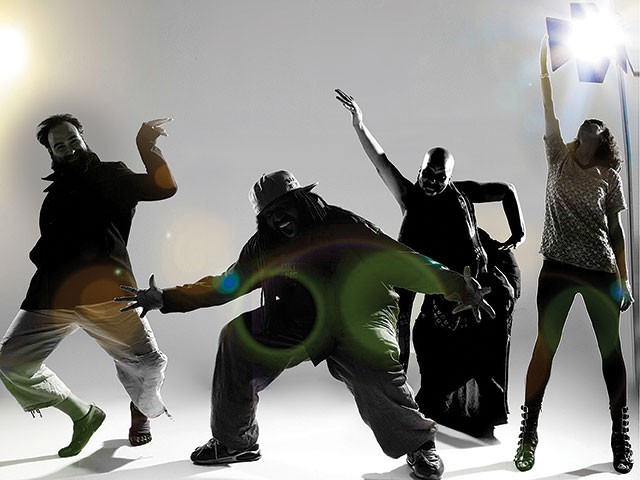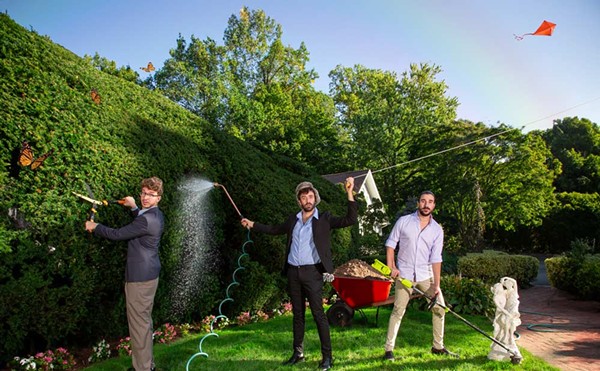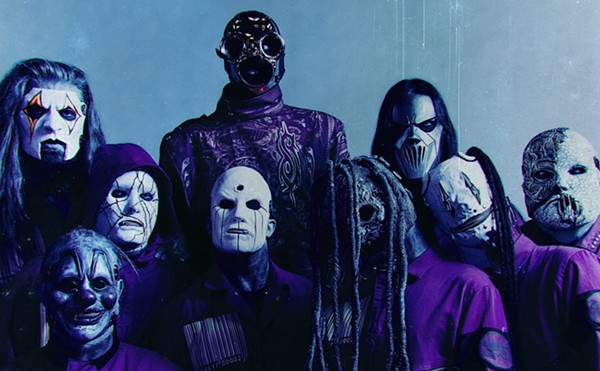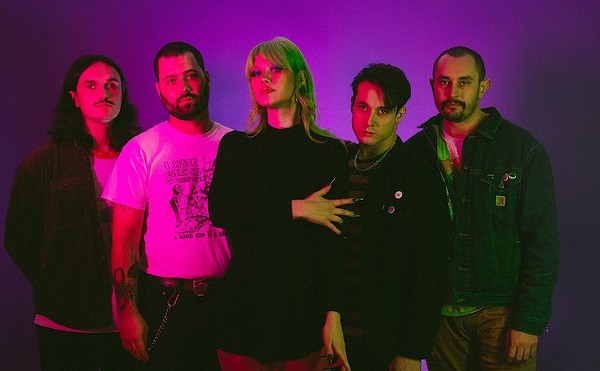The 4th Wall CD Release Party with Solillaquists of Sound, Blueprint, E-Turn & SPS, Beef Wellington
9 p.m. Saturday, Jan. 11 | The Social, 54 N. Orange Ave. | 407-246-1419 | thesocial.org | $15-$20
Solillaquists of Sound are done. Orlando’s first family of hip-hop has, as the title of their new album (The 4th Wall) suggests, demolished all boundaries. And even for this provocative group, the finality with which they’ve done it is a stunning surprise.
The 4th Wall wraps The Listener’s Trilogy, a three-album story arc that consumed and defined the lion’s share of the group’s colorful and illustrious career. It’s an epic, spanning seven years, that’s taken them from the DIY underground to signed international profile and back. It envelops the entirety of the elaborate Solillaquist universe, and they are about to smash it to pieces.
If quality, longevity and success are the measure, Solillaquists of Sound are one of the greatest breakout stories in not just Orlando hip-hop, but in Orlando music history. Dominating this publication’s Best of Orlando readers poll for “best hip-hop act” for the past decade, the group – a pair of couples (executive producer-MPCist Glen “DiVinci” Valencia Jr. and poet-listener Tonya Combs; lead MC Asaan “Swamburger” Brooks and lead vocalist Alexandrah Sarton) – is the city’s alternative rap touchstone. Their odyssey has included group accomplishments like a record deal with respected Epitaph sister label Anti Records (signed in 2006), international tours and filling in as Sage Francis’ band, as well as individual achievements like membership in Lauryn Hill’s band, a mention in The New York Times and an MPC product development consultancy with Akai.
The style trajectory of their Fugees-esque dynamic has gone from playing up pure hip-hop roots to transcending the genre altogether with a sound that now liberally references funk, soul, rock, jazz, dance and electronic alongside classic rap pedigree. Although it’s confounded many – the listening public and the industry alike – it is what has ultimately defined the Solillaquists.
It all began in 2002 when the Solillaquists blindsided Orlando by releasing their first album, 4 Student Counsol (Nonsense Records), before ever performing out. Although their subsequent releases were staggered (As If We Existed in 2006 and No More Heroes in 2008, both on Anti/Epitaph), it was due to diligent song crafting and their nonstop individual endeavors, never inactivity. After fulfilling their contract with Anti, the band delved back to their DIY roots and independently released this year’s The 4th Wall.
Group mastermind DiVinci says, “Before [trilogy opener] As If We Existed came out, we just met so much resistance in the hip-hop community of like, ‘You guys aren’t hip-hop – you guys are experimental; you guys are electronic.’ But people forget that [hip-hop] was actually a movement that could be continued. And that’s kinda what we were doing! That’s what we have been doing and what we are still doing.”
Although DiVinci himself was already experimenting beyond the hip-hop fence at the outset, Solillaquists’ early work was more orthodox.
“The stuff we put out first was more in line,” he says. “And there’s a reason for that. I always wanted to show people a process … I wanted to show people, ‘Look, I want to show you that you can do this in this genre. I didn’t just want to jump to experimental and [have] people detach it. I wanted it to be connected. I wanted people to see, ‘Oh, here’s an evolution of hip-hop,’ as opposed to ‘Oh, that’s just electronic,’ or ‘That’s just EDM’ or whatever you wanna call it.”
This widening spectrum finally arrived in grand, exciting fashion with the trilogy’s middle chapter, the groundbreaking No More Heroes. And it continues with the even more liberated new album. While noting that Solillaquists honor the roots of hip-hop, DiVinci cites acts like Afrika Bambaataa and Mantronix and emphasizes, “It can be more.”
And “more” has always been the Solillaquist operating rule. Their music and identity are a group-based juggernaut that, rather than color within the lines of traditional hip-hop, expands it into another dimension, one wholly of their original design. But more than just sound, they’ve crafted their modern realm as a highly layered, multimedia (audio, visual, video), interactive storytelling experience, something much more kindred to the complete inner realities of video games and comic books than standard albums. The albums themselves are packaged with not just lyrics and notes but detailed, narrative and symbolic illustration from Swamburger, who’s also one of the city’s most distinctive and accomplished visual artists. It’s a full-sensory campaign designed to immerse and engage.
As suggested by the title, engaging the listener is the primary focus of The Listener’s Trilogy and, by all outward measure, the raison d’être for Solillaquists of Sound. The listener is such a core element of their work that one of the group members, Combs (aka “the Listener”), is designated to embody it.
The aim of Solillaquists’ engagement isn’t just about attention – what they preach is action and actualization. And reflective of their tenor and their politics, they do it with a directness and earnestness that’s exceptionally rare. Unlike the insular, unilateral mode of expression of many artists, the connection and exchange with the listener is, for Solillaquists, what defines the experience of their art.
“I just wanna fuckin’ dialogue with people,” says DiVinci. “The biggest part that sucked about being on a label was that there was a middleman between us and them, whereas before it was always just us and them. When it comes down to it, yo, I don’t fuckin’ sit in front of my computer and kill myself for nothing, to throw out our album and have people go like ‘eh.’ If this ‘eh’ means something, have a fucking conversation with me. At least that gives me something palpable to attach to my experience with it. You can’t make something and put it out there, and someone just doesn’t react. You get into a bubble as a musician, especially nowadays.
“As soon as that started to happen, I went back to our oldest of email lists – a thousand people – and I wrote this big, long letter and was very honest and talked to people and said, ‘Hey, look, I just wanted you to check this out. But really, more than anything, I wanna just know that you exist.’ And the responses I got back were amazing. And it was cool because I actually heard an echo. I didn’t just hear me yelling into a cavern. I actually heard someone call back. And that has been the greatest experience about all of this, was the fact that, yeah, if I’m not gonna have all the money that all this work would equate to, at least give me some feedback, good or bad. At least give me something that makes me feel like I did do work.”
Having fulfilled their label contract, Solillaquists self-released their new two-disc album through fan funding.
As usual, Solillaquists wanted to deliver their work in a lavishly tactile way instead of simply digital, and the group wanted to see if the public agreed. They did. Instead of the shoestring budget that DIY typically implies, their Kickstarter campaign shattered its $12,500 goal in two months (ultimately earning $16,393). And this release comes in their most luxe packaging to date, more hardcover box-set book than standard CD case. They may be back to the grass roots, but they’ve come a long way.
“The thing is, we never stopped being DIY,” DiVinci says. “We had somebody’s logo to put up on our stuff, but our [personal] efforts only increased, you know what I mean? And I guess that was kind of the frustrating part, because with the increase in our efforts, we didn’t see too much of the industry saying ‘Oh yeah, yeah, let’s match that.’ Or, ‘Let’s even try to get 40 percent of that.’ It doesn’t feel any different.”
With the conclusion of their trilogy, Solillaquists are doing the full reveal and rolling out everything that went into – and behind – their story. The double album comes accompanied by a 24-page listener’s guide for the trilogy that’s part manual, part manifesto – essentially a blueprint to the astoundingly complex Solillaquist world. It’s a completist’s fantasy and a booming defiance of a compressed and facelessly digital age.
“We want to give people an experience,” he says of the trilogy saga, which is also now available as a box set. “We didn’t just put out an album, because that didn’t match up to what we were trying to say. What we were trying to share, really, was this experience. You can’t do that just through music … we couldn’t achieve that in one album. We barely achieved it in three. And we tried everything else, like hiding stuff in artwork, and creating this mystique and this whole science behind everything, just so that if people wanted to go deeper with it, they could.”
Now, Solillaquists are in the home stretch of a grand concept that’s taken them far in art, travel and career. When asked to measure the group’s certified success against his personal expectations, DiVinci replies with typical and unforgiving frankness:
“I thought [it would be] more. In all honesty here, it’s great; I don’t want to be ungrateful for what we do have. But you see so many balls dropped in the hands of others. So many things where it’s like this coulda went this way/this coulda went that way, so easily that, to me, I see so much more opportunity for us to be really successful, you know? And I think a lot of people look at our level of success and say, ‘Yeah, they fuckin’ made it.’ But for what we had in mind, we didn’t really get to where we were shooting for.”
But right as he’s on the verge of expressing frustration with the game, he takes a turn toward naked emotion that is too surprisingly in the moment to be premeditation and too raw to be affectation.
“Having said that, I really …” He trails off, the dam of his face straining to contain some internal surge. He continues, mostly composed. “Another side to that coin, right? I’m happy, personally, that whatever success we didn’t get – that I was shooting for – we didn’t get. Now, I’d still like it. But I don’t give a fuck anymore; because the things I was able to learn with this group, I’m … phew …” He starts to crack again. “I’m a fucking millionaire, you know?” That’s when he breaks, eyes welling with tears.
In faltering voice, he continues, “It’s fucking amazing, you know? I know if I would’ve gotten the dreams I constructed as a 14-year-old – wide-eyed, looking at the industry like it’s all it could’ve been – I know I wouldn’t have had the growth that I had this way.”
DiVinci next goes into an impassioned discussion of values and how the systemically flawed music industry can seduce you from your compass.
“I would’ve been totally caught up,” he says. “I know I would’ve. I got caught up in the level of success we did have … Thankfully, I’m in a group that would never allow [any] one of us to really go in that direction. We have great pillars of people and great pillars of reasoning that have helped keep us in line.”
As a result, he says, “I’m a quadrillionaire in substance, as far as what I’ve gotten from this group. Because of not being able to get immediately what I wanted through the industry, through the dreams I built as a tween, I was able to really have to look other places to find out what I needed. And I totally got it, in spades.”
But even amid all the fanfare surrounding their big public unveiling of The 4th Wall (Jan. 11, the Social), the looming fact is that the album is a finale. What happens next is a very real question, one that I ask DiVinci point-blank. He reads me the concluding passage in the liner notes of the new album – the batch of which had just arrived in the mail the day of our interview – and it staggers me. Besides rolling back the curtain with this magnum release, they’re also bringing it down.
“With this album, Solillaquists of Sound, as people know it, as we know it, is dead,” he drops. “What this means now is that, all this structure we built, fuck it. … We’ve done all we can within the structure, within the industry, within the crazy structure of this trilogy. … These things that had been written years in advance playing out years later; that’s structure like a son of a bitch. That takes a lot of discipline … and we’re so ready to just leave all that structure behind and just be really free.”
But, as with all things Solilla, things are always more than what they first appear. True to their theatrical storytelling style, the parting message in the album is filled with ciphers that may not make sense for months – possibly years – to come, or at least not without some inside information. And that’s something you’ll have to dialogue with them about.

















